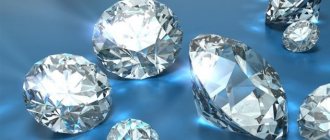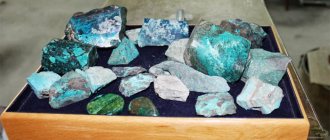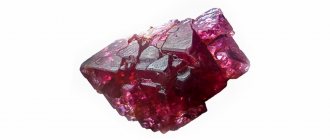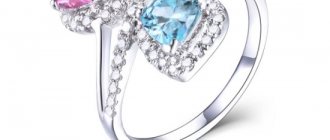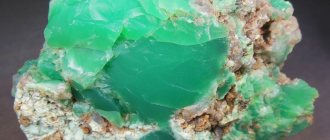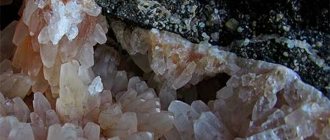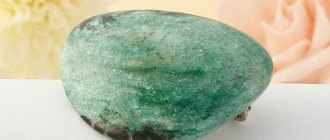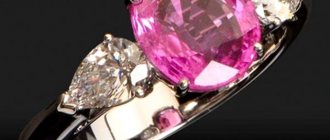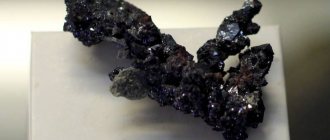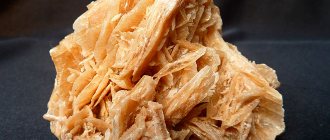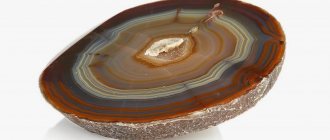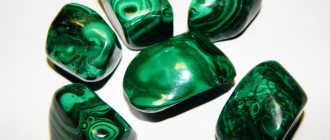Lava stone is solidified magma ejected from a volcano. Another name is basalt, which literally translated from Ethiopian means “boiling” and reflects the origin of the mineral. Hot lava erupts from the depths of the volcano, comes into contact with the air and literally boils. Lithotherapists believe that volcanic lava is a stone with magical properties that combines the power of all the elements.
History and origin
Lava is a stone that is unique in every way; the history of this rock goes back deeper than that of any other nugget. Being the breath of our planet, lava exists exactly as long as the Earth has been erupting magma from its depths for thousands of years.
It was not for nothing that our ancestors attributed immeasurable power, magical and healing powers to lava. The volcano was once considered the point of connection of the four elements - Earth, Fire, Air and Water. Magma, arising in the heart of the planet under the influence of the first two elements, became lava, escaping with a powerful exhalation from the distant depths. With the help of the power of Air, the magma cooled and flowed into the ocean, absorbing the forces of the last of the elements. Today lava is born in the same way as millions of years ago, bringing with it extraordinary possibilities.
This is interesting! Lava stone is also known by another name - basalt. This name for the nugget, based on the peculiarities of its origin, was given by the African country of Ethiopia. Translated from the local language, “basal” means “boiling.” The word “lava” itself came into our language from French, as well as Italian, about three centuries ago, translated as “sliding”, “creeping” or “falling”. This name no longer reflects the formation, but the birth of the stone, its rebirth.
Before it reaches the surface of the earth, lava is considered magma. The temperature of the magma before the eruption reaches 2500˚C, and after it gradually decreases to 500 degrees. When erupting, magma changes properties under the influence of atmospheric gases, turning into lava. If streams of hot mass encounter a body of water on their way, a powerful explosion occurs.
Gas bubbles often leave voids on the surface of the rock. Such porous material turns into pumice. When lava cools slowly, its top layer forms a crust, under which other layers remain liquid longer and continue an invisible internal flow. In the middle of the flow, tunnels are often formed due to the different speed and direction of the flowing mass. Such voids can extend within the flow for a distance of up to 15 km.
It is known that lava from different areas of origin differs in composition. The volcanic material of island arcs (places where oceanic plates are superimposed on one another) is andesitic in composition, while the lava of oceanic ridges is predominantly basaltic in composition.
Scientists have long sought an answer to the question of why some areas produce lava of both compositions, while others are notable only for basalts. The answer was the theory of tectonic movement of lithospheric plates, which states that oceanic crust moves under the island arcs, which, when melted at a certain depth, erupts with andesite lava.
Healing accessory
Do you want to recharge yourself with positive energy and protect yourself from all kinds of negativity? The original Lava Bracelet will help you with this, real reviews, about which you can see only commendable ones on the Internet. The bracelet eliminates possible negative influences in your direction, improves your general condition, lifts your spirits and also serves as an extraordinary decoration that complements your image.
Real reviews of “Lava Bracelet”
Price and where to buy
Interested in a lava stone bracelet? You can only buy it on the official website. Only there they are guaranteed to sell original jewelry that will pleasantly surprise you with its high quality and properties.
When ordering in the online store, the cost of the bracelet is 1,290 rubles. You can rest assured about fast delivery and confidentiality. Payment occurs upon receipt of the parcel at the post office. No prepayment required.
Description
Usually, every person has some kind of amulet that helps and protects him, and also attracts only the best to its owner and thus makes him happy. The lava bracelet is both a talisman and a stylish decoration. It is made of lava stone, which is known for its incredibly beneficial properties.
Researchers of basalt stone say that it can provide significant assistance in normalizing biorhythms and increasing human energy. Additionally, it has been proven that people who live near volcanic rocks have excellent health and energy levels.
That is why the presented jewelry is so useful for everyday wear. The more often you wear such a bracelet, the faster and better the result will be, once you start wearing this wonderful accessory.
Principle of operation
The presented product is filled with the energy of the earth element, therefore it has the most beneficial effect on humans. As the manufacturer notes, the bracelet can cleanse your energy of accumulated negativity, it instantly removes damage or the evil eye, eliminates chronic fatigue, and makes it easier to endure stressful situations.
Most often, jewelry receives reviews from buyers who had health problems before purchasing the bracelet. In their comments, people express gratitude to the manufacturer for getting the truly desired result - their overall health has improved, all internal organs have begun to function better, and even serious illnesses are a thing of the past.
The original bracelet successfully passed clinical studies, as a result of which it was revealed that the jewelry affects the body in the following way:
- increases immunity and the body’s protective properties;
- eliminates harmful substances in the form of toxins and waste, cleanses the body and tones it;
- relieves any pain, for example, muscle, joint, headache;
- restores the functioning of all internal organs.
Clinical trials of the product also confirmed that the bracelet has powerful therapeutic powers and has a positive effect on the body.
Compound
It should be noted that the lava stone bracelet has incredible health benefits. The thing is that lava has a positive effect on the chakras. It is a kind of conductor of cosmic energies that are transformed into the physical body, thereby adapting to human biological rhythms.
This bracelet can and should be worn by absolutely everyone, there are no restrictions, the product has no contraindications or side effects.
How to use
The presented decoration can be worn with any clothes, it looks very stylish and suits different styles. Many celebrities have purchased this product, and now it is their personal assistant in difficult times and a talisman.
When putting on this jewelry, the main thing is to believe in its incredible properties, then the effect will be even better and you will notice it yourself. Lava stone can quickly restore health and protect a person; in addition, a bracelet can change the life of its owner for the better, because it attracts good luck and strengthens energy, removing all negativity.
Advantages
None of the buyers have yet complained about the Lava Bracelet or left negative reviews about it.
People buy this product for various reasons, some want to restore their health, some simply want to protect themselves from damage or the evil eye, and some want to attract good luck into their lives.
Whatever the purpose for which you acquire this beautiful piece of jewelry, it will become useful to you and this will be noticeable as soon as you start wearing it.
Benefits of the bracelet:
- eliminates any negative impact;
- activates vital forces;
- successfully completed research;
- healing composition;
- looks good;
- a lot of positive feedback;
- acceptable price.
Source: https://otzyvreal.ru/raznoe/lavovyj-braslet.html
Place of Birth
Lava stone originates and is mined wherever volcanoes rise. The peculiarity of the extraction of this stone is that this process depends on the phase of volcanic activity - if the volcano is active, then the deposits are not developed until the masses are finally formed. When it comes to dormant volcanoes, the lava often lies at a certain depth, forming layers. The age of such rocks often dates back to the Precambrian period.
This is interesting! Sufficient amounts of lava stone are mined all over the world for human needs. However, geologists are convinced that the main percentage of the earth's rock reserves are stored in the Pacific Ocean floor. It has been proven that the basis for the formation of the Hawaiian Islands is basalt rocks. But for now, there is no need to develop the ocean depths.
Places where lava stone is mined:
- Iceland.
- India.
- Greenland.
- North and South America.
- South Africa.
- Ethiopia.
- Australia.
- Tasmania.
- China.
- Italy.
Also read: Anhydrite is a conductor of lunar energy
Any island with a volcanic peak contains an excess supply of lava rock. Russia, as a storehouse of unique stones, is also rich in basalt. Lava is mined in the north of the country (Kamchatka).
Physical properties
Lava is a porous stone, predominantly black or dark gray in color, with a fine-grained structure. The composition of the breed differs depending on its origin. Each type of stone contains dozens of chemical elements, but iron, aluminum, magnesium, silicon and oxygen have the advantage.
| Property | Description |
| Compound | SiO2 approximately 40 to 95% |
| Lava temperature | from 500 to 1200 °C (up to 2500 °C at the time of pouring and a short period of time after) |
The chemical composition and temperature of formation affect the viscosity and fluidity of lava. The predominance of quartz makes the lava thick, the mass flows slowly, hardens in the form of mounds. The absence of silicon dioxide gives free rein to lava flows - liquid in consistency, such a substance spreads rapidly, forming lava plateaus, covers and lakes. Such a stone is less porous, as it is quickly freed from the gases that saturated it.
Varieties and colors
Different volcanoes erupt volcanic material of different composition, temperature, and color. There are three types of lava based on their composition:
- Basalt. This type is considered the main one. In basalts, 50% of the chemical composition is silicon dioxide, the remaining half consists of oxides of various metals, including iron, aluminum, and magnesium. The flow speed of such a substance reaches 2 m/s, and the temperature is 1300˚C, which causes a multi-kilometer, but small-thick covering of the earth's surface. The color of basalt that has not yet hardened is yellow or red-yellow.
- Silicon. It is a viscous volcanic material with a temperature of about 900˚C. The flow rate is low, only a few meters per day. Viscosity and low fluidity are determined by a higher percentage of silica than in basalts - from 53 to 62. When the part of silicon dioxide reaches 65%, the lava becomes even slower. A special feature of silicon lava is that the material hardens before leaving the crater. The lava solidified inside usually clogs the vent, which leads to a strong explosion during the resumption of the eruption. The color of hot silicon lava is black with a hint of red. Silicon masses quickly solidify without having time to crystallize, forming black volcanic glass.
- Carbonate. This species is notable for the fact that it erupts from the only volcano on our planet - the Tanzanian Oldoinyo Lengai. Half of the composition is occupied by potassium and sodium carbonates. This lava is considered cold and the most fluid, almost like water. The temperature of carbonate volcanic material does not exceed 600˚C. Hot lava of this type is usually dark brown or black. However, after complete cooling, the rock changes color to white, becomes brittle, soft and soluble in water.
Lava is also classified according to its form of solidification. There are:
- Aa-lavu is a stream torn into pieces, solidifying into separate blocks.
- Pillow lava or pillow lava is volcanic material frozen on the ocean floor in pillow-shaped bodies.
- Pahoehoe lava is a Hawaiian name meaning smooth, swollen, or wavy lava.
There is also a difference between basalt lavas according to some criteria, the main ones being color, structure and application. This classification is more industrial than scientific:
- Asian. A dark gray stone used in architecture and also in the production of costume jewelry.
- Basaltina. The ancient Romans knew this variety. Basaltine is considered a more expensive variety, as it is durable and retains its original appearance for a long time. Used in sculpture. Externally it resembles limestone.
- Twilight basalt. The birthplace of this stone is China. The rock is used in construction because it is the strongest among all varieties and has the best resistance to atmospheric factors. The color of the stone is black or dark gray. It is also used in the manufacture of costume jewelry.
- Green Moorish basalt. The nugget contains unusual inclusions that give the stone a rich green color. Thanks to this, this variety looks noble and expensive in jewelry.
Also read: Diorite - features of volcanic rock
Each type of stone is used in different fields - esotericism, lithotherapy, industry and jewelry.
Types of Lava Rocks
The process of “melting” rocks in the depths of volcanoes is easy to imagine. Everything boils, hisses and gurgles deep inside the Earth. But there is not enough room for the “cooking porridge”, and this liquid mass breaks out to the surface through the crater of the volcano. Molten magma contains almost all the elements from the periodic table.
Magnesium and potassium, aluminum and titanium, phosphorus and sodium, calcium and aluminum are mixed together. Various chemical compounds are formed. Partially chlorine, fluorine, carbon, hydrogen and other gases evaporate as soon as the mass is released into the air. Magma turns into lava. Hence the name of rocks and stones - lava or volcanic.
This is how we get the familiar ones:
- obsidian;
- pumice;
- pechstein;
- basalt.
This group also includes volcanic tuff, an effusive rock made from ash and compacted stone fragments. It is used in construction as a stone for building walls. The material is easy to process and can be handled with a saw or axe. This is a very valuable quality of tuff, which comes in gray and black, pink and red, yellow and orange, purple and white.
Each of the stones of volcanic origin listed above is not at all similar to its neighbor - neither in appearance and physical properties, nor in area of application.
Igneous rock: andesite
Andesite is an effusive igneous rock, the silica content of which is higher than in basalt and lower than in rhyolite or felsite.
As a rule, it is the percentage of silica in a volcanic rock that determines its color, which is why basalt is dark, and felsite, on the contrary, is light. Although geologists will always chemically analyze a rock before determining its type, in the field, the gray or reddish colored rock is often classified as andesite.
The volcanic stone received its name from the South American mountain range (Andes), where large deposits of this rock were discovered, and where andesite was first mentioned in printed sources. Andesite is less fluid than basalt, and erupts with greater intensity because the gases dissolved in it have a harder time escaping. Andesite is classified as the effusive equivalent of diorite.
Volcanic stone anorthosite
Anorthosite is an unusual plutonic rock composed almost entirely of plagioclase feldspar.
Anorthosite is one of the oldest rocks of the earth's crust. Anorthosites are usually found in areas where ancient igneous rocks are exposed and exposed. Anorthosite is used in industry, as a building material and cladding stone.
Volcanic lava: diorite
Diorite is an igneous rock that is a cross between granite and gabbro. Diorite is mainly composed of plagioclase feldspar and black hornblende.
Unlike granite, diorite contains a very small amount of quartz or alkali feldspar (anorthoclase), and sometimes there is a diorite rock in which these minerals are completely absent.
And unlike gabbro, diorite has a rather light color - half black and half white - when examined under a microscope, it is clear that the diorite contains sodium rather than calcareous plagioclase. If diorite lava erupts from a volcano (that is, if it is of an effusive nature), then, in this case, as it cools, it turns into andesitic rock.
Typically, geologists refer to a wider range of rocks as diorite than its official definition suggests. However, diorite with higher quartz content transforms into tonalite, and increasing anorthoclase concentration leads to the formation of monzonite. With an increase in the content of both minerals, the diorite rock turns into granodiorite.
Dunit
Dunite is a plutonic rock composed of more than 90 percent olivine with a small amount of chromite. The breed got its name in honor of the Doon Mountains located in New Zealand.
The breed comes in light green and dark green colors (sometimes almost black varieties are found) with a massive texture.
Dunite is used to make refractory materials and is also used in foundries.
Volcanic stone: felsite
Felsite is the name given to all light-colored stones of volcanic origin. Felsite is a fine-grained rock with a light matte color that may or may not contain phenocrysts (large mineral grains).
It is characterized by a high silica content and belongs to acidic rocks, usually consisting of quartz, plagioclase feldspar and anorthoclase. Felsite is commonly referred to as the effusive equivalent of granite.
A typical representative of felsic rock is rhyolite, which includes phenocrysts and phenocrysts of colored minerals, sanidine and plagioclase. Felsite should not be confused with tuff, a rock composed of compacted volcanic ash, which can also be light in color.
Gabbro
Gabbro is a dark-colored volcanic rock that is a plutonic analogue of basalt.
Unlike granite, gabbro contains no quartz and low silica content, and no alkali feldspar, only plagioclase, usually dark in color with a high calcium content.
Other dark minerals may include hornblende, pyroxene and sometimes biotite, olivine, magnetite, ilmenite and apatite.
Porphyry
The name porphyry is used for igneous rocks with clearly visible mineral grains - phenocrysts - surrounded by a ground mass of fine-grained rock.
Geologists use the term porphyry with a qualifying word to refer to the structure of the underlying rock. For example, andesite porphyry or rhyolite porphyry. As a similar name, such a rock can be called andesite or rhyolite with a porphyry structure.
Granite
Granite is composed of quartz (grey), plagioclase feldspar (white) and alkali feldspar (beige), plus dark minerals such as biotite and hornblende.
Granodiorite
Granodiorite is a plutonic rock composed of black biotite, dark gray hornblende, grayish-white plagioclase and translucent gray quartz.
Granodiorite differs from diorite by the presence of quartz, and from granite it is distinguished by the predominance of plagioclase feldspar over alkaline feldspar. Despite the fact that this stone cannot be called a true granite, granodiorite is part of the group of granitic rocks.
Reddish colors indicate the presence of rare pyrite grains, which, when oxidized, release iron molecules. The chaotic arrangement of grains indicates the plutonic nature of the origin of the rock.
Tonalite - a stone of volcanic origin
Tonalite is a common but unusual plutonic rock, a granitoid that does not contain alkali feldspar, also called plagiogranite and trondhjemite.
Granitoids are concentrated around granitic rock, being a mixture of quartz, alkali and plagioclase feldspar in relatively even lobes. As alkali feldspar is removed from true granite, the rock becomes granodiorite and then tonalite. In the composition of tonalite, feldspar is completely absent, which is compensated by the increased concentration of quartz.
Obsidian
Obsidian is a dark-colored glassy stone formed when viscous acidic lava hardens.
Properties of obsidian:
Black color
Mohs hardness: 5-6
Density g/cm3: 2.3
Gloss: Glass
It is very easy to obtain a piece of obsidian as it is easily separated from the underlying volcanic rock. These stones, formed from lava, were noticed approximately 9 thousand years ago. Our ancestors noticed that the stone is hard, dense, easy to sharpen, does not chip and does not dull for a long time. These properties made it the main tool of labor and hunting. Obsidian was used to make spears, knives, arrowheads, scrapers, and axes. Surprisingly, with modern technology and the development of culture, obsidian is used in the same way as in Paleolithic times. Knives and scalpels are made from it, since obsidian, unlike metal, can be sharpened very strongly. At the same time, it does not chip or become dull.
Obsidian later spread throughout the world, not just in areas where volcanoes were present.
However, despite the long history and prevalence of the mineral, its name was given only during the times of Ancient Rome. At the same time, it began to be used as decoration. The stone was named after Obsidius. He was the first to show the mineral found in North Africa to the Roman emperor.
Rome was then known as a trendsetter and a center of the arts. High society liked the new mineral and they began to make rings, vases, sculptures and other jewelry from it.
Obsidian looks mystical: it is black, translucent at the edges, with a glassy sheen. Moreover, he was once lava and was born in volcanic fire. It is not surprising that occult properties were immediately attributed to him. Ritual knives for sacrifices, masks of the dead, and fortune-telling mirrors were made from it.
Belief in the extraordinary properties of the stone has been present in many countries for many centuries.
- the Aztecs fought the conquistadors with obsidian weapons;
- Christians made rosaries;
- Yogis used the stone to connect with the energy of the Earth, since it retained volcanic energy.
In some European countries, obsidian is still worn only for funeral ceremonies. In Transcaucasia, they were afraid of obsidian, believing that it came from the underworld. In the 19th century, thanks to the Faberge jewelry house, a new wave of popularity for the stone began. Rich jewelry and decorative items began to be made from it again.
It is generally accepted that obsidian is a black stone, but more interesting examples are found. For example, snowy obsidian with white spots or rainbow obsidian with streaks of different colors, reminiscent of Labradorite. The color depends on the admixtures of other minerals in the lava.
Basalt
Another common volcanic stone is basalt, formed from basaltic lava.
No one knows exactly where the name of the stone came from. There is a version that it comes from the Greek basis - “base”, but in one of the African dialects there is the word “basal”, which translates as “boiling”. Both options are not far from the truth and perfectly describe the characteristics of the stone. Basalt was really hot boiling lava that poured onto the ground. This is one of the most common rocks that underlies continents and the bottom of the oceans.
Main basalt deposits:
- volcanoes of the Klyuchevskaya group;
- a group of volcanoes in West Africa;
- Himalayan mountains.
Depending on the deposit and age, it varies in appearance. For example, in the vicinity of the volcanoes of Kamchatka, on Klyuchevskaya Sopka, young beautiful basalts are found, in the vicinity of Vesuvius and Etna there are remarkable green samples, in Hawaii there are gray and black basalts. Many varieties are found in India, since the Hindustan tectonic plate, crashing into the Eurasian plate, turns outward the deep basalt layers.
In some areas, liquid volcanic rock erupted and became saturated with gases. Due to this, when solidified, cavities were formed, which were subsequently filled with other minerals that crystallized from the lava.
It is rarely used in the jewelry industry because this volcanic stone is not beautiful: it is not bright, not shiny, and expressionless. However, there are designers who use rare and beautiful varieties to make silver jewelry that looks unusual and can even complement an evening dress.
However, this is rather an exception. It is most often used in construction and architecture. This rock melts at a temperature of 1250 degrees Celsius. This property is used for the production of cast stone products. Most often they are used in decoration.
Mineral wool is also made from basalt, which is used as a heat and sound insulating material.
Healing abilities
Lava stone is popular among healers as a massage product. Balls made of mineral, when exposed to massage movements, help get rid of blockages in blood vessels, relieve the symptoms of varicose veins and joint diseases. Volcanic rock is also used in the fight against cellulite.
Lava pendant
It is known that lava retains heat for a long time. In contact with the human body, the nugget, together with warmth, transfers the entire range of beneficial properties to the body, thereby strengthening the immune system, relieving tension and stress.
Meditation using basalt is considered beneficial. This helps to reboot the body at all levels, giving the body and mind a break from excessive life activity.
Lava stone stabilizes the emotional background even when carrying a nugget every day. The mineral will give a person lightness, fill him with energy, relieve fatigue, and transfer to the owner all the deep power of the earth. Ancient healers made powder from lava, using it to heal wounds.
Massage with lava stones:
Benefit for health
Pieces of magma are of great importance for maintaining the health of an individual.
Constantly wearing a talisman helps:
- Improving metabolism in the body. Igneous rock affects the stomach and intestines. Food begins to be quickly digested, unnecessary substances are eliminated from the body.
- Relieving any pain. If you experience pain in your head, muscles or joints, you need to take the talisman in your hands and relax. After a few minutes, the discomfort will disappear.
- Stabilization of the functioning of all body systems. Internal organs receive positive charges from the lava stone and begin to work in accordance with the rhythms of nature.
Important! Basalt, upon contact with the owner’s body, triggers rejuvenation processes. When worn, a person feels a surge of strength, his mental health will be strengthened. Starts to work at full capacity.
Massage balls are created from volcanic mineral. They are very effective in the fight against excess weight and cellulite. Procedures with the following accessories:
- improve blood circulation;
- help to relax severe muscle tension;
- relieve spasms and pain;
- help normalize blood pressure.
From igneous rock, master stone cutters make various utensils for grinding medicinal plants, preparing tinctures and mixtures. Healers claim that drugs that have been in lava tanks acquire additional healing power.
Medicinal properties
Strength, courage, energy, creativity, increased libido, fertility, aura cleansing, antibacterial, antiviral, disinfectant - all these are the healing properties of lava stone.
What does lava rock look like?
To enhance the effect, the mineral can be combined with essential oils. Two of the most popular essential oils used on lava stones are lavender and lemon. The stone tends to absorb oils quite well and will hold the scent perfectly for a long time.
Applying lavender essential oils to a lava ball can help reduce anxiety, relieve stress, and promote a restful night's sleep. Using lemon essential oil will give you more vibrant, positive and healthy energy throughout the day.
The mineral acquires antiviral and antibacterial effects only in combination with esters, enhancing their benefits. Fir, pine, and cedar oils are suitable for this.
Lava stones are good for massage, they restore strength in a person, remove stagnation, dissolve pockets of salt deposits. Lava is a reliable ally in the beauty of the skin - rejuvenates, saturates it with oxygen. Heated volcanic stones are good for treating bone problems and removing arthritic tumors. Helps with acute attacks of radiculitis and osteochondrosis. Therapy with hot or cold stones appeared about five thousand years ago.
Magic properties
It is not surprising that the heart and breath of the planet has strong magic, helping a person at all levels of consciousness and subconscious. Lava is responsible for the root chakra - the basis for the activity of other chakras, connecting human energy with the energy of the Earth. The lava stone itself is energetically both feminine and masculine. Rough lava carries Yang energy, while smooth, flowing lava carries Yin properties.
Lava is considered the oldest home amulet, used by tribes around the world. If you want to protect your home from troubles or uninvited guests, place pieces of lava stone at the entrance to your house or store jewelry made from the mineral as close as possible to the entrance.
Wearing basalt harmonizes a person’s inner world. Thanks to this, the owner of the stone learns to understand himself and his own thoughts, desires, and dreams. Contact with the stone sharpens intuition and teaches you to correctly interpret messages of fate, dreams, and signs. A person feels unity with himself and nature, reveals talents, gains wisdom, which must be directed to the implementation of the most daring plans.
It is also believed that one of its physical properties, fluidity, is transferred to the owner by lava. This allows a person to become flexible, morally flexible, adapt to any current of circumstances, while not losing sight of the intended goals. Thanks to such properties, a person is open to everything new, while the talisman protects against mistakes and wrong actions.
Since ancient times, a lava nugget has been considered a stone of knowledge. If anyone strives to acquire new knowledge, it is necessary to carry a basalt talisman with him. The stone helps to clarify thoughts and reveal mental abilities. It is easier for a person to concentrate on work and achieve perfection in studying the chosen science.
Lava will become a sacred talisman that will definitely bring positive changes. This stone does not like stagnation; calm is alien to it. With the arrival of any person in the life, lava stone will constantly push the owner to move, take decisive action, and achieve goals.
Areas of application
Lava turned out to be a multifunctional material for humans. Our ancestors identified lava as special stones. During excavations of ancient settlements, archaeologists found not only jewelry, but also tools, masks, and ritual attributes.
Also read: Dunite - volcanic rock
The areas of use of the nugget are varied:
- Lithotherapy. Massage balls are made from stone.
- Decor. Aquariums are decorated with lava stone. The mineral not only serves as a beautiful addition - thanks to the presence of lava, the water circulates better, while being filled with all the useful chemical components.
- Grill. Expensive grills use lava rather than charcoal. This stone maintains heat and warmth better.
Rock experts have classified basalt as a mixture of basaltic lava and ash that hardens instantly after an eruption. Such basalt has found application in construction, as it has valuable characteristics - strength, noise insulation, thermal conductivity, fire resistance, and durability. Slabs and basalt wool are made from it, the remains are crushed and added to asphalt and concrete.
Volcanic stone is used to lay floors, fireplaces, building facades and tombstones. The only disadvantage of a basalt floor is that over time the stone is polished until it slips icy. In addition, sculptors, furniture makers, and clothing designers use basalt. Jewelers create beautiful silver jewelry with black stones. And although lava products are not so popular today, craftsmen still make beautiful jewelry.
What products were made from stone in the distant past and what are made today
In ancient times, people knew about the magical properties of this stone, so they made the following from lava material:
- jewelry for women that protected them from evil forces, influenced women’s health and gave them vital energy;
- figurines of gods, as they were considered talismans that brought good luck;
- figurines for magic spells.
Over time, volcanic material began to be combined with noble metals such as gold and silver. Various rings, pendants and brooches looked great with the eye-catching black stone: the metal shimmered and emphasized the beauty of solidified lava.
Over time, stone became a very popular material. Today, in addition to jewelry, unusual sculptures, figured mosaics, stylish tiles and original tabletops are also made from it. The black color of the mineral goes well with any texture and color.
Jewelers and healers simply adore him. The former use it to create very beautiful and unusual jewelry, and the latter use it as a powerful amulet.
Jewelry with mineral
Lava stone is an affordable material, so products with this mineral are affordable. The average cost of jewelry is:
- Bracelet – 350 rubles.
- Earrings – 500 rubles.
- Beads made from a mixture of stones (pearls, agate, lava) - about 2000 rubles.
Stone beads
Jewelry with lava stone is often complemented with other ornamental minerals, such as tiger's eye, lapis lazuli, agate. There are no fakes, since this material is more than enough, and the cost is already low.
Astrological compatibility
(“+++” – the stone fits perfectly, “+” – can be worn, “-” – is strictly contraindicated):
| Zodiac sign | Compatibility |
| Aries | +++ |
| Taurus | + |
| Twins | +++ |
| Cancer | + |
| a lion | +++ |
| Virgo | + |
| Scales | +++ |
| Scorpion | +++ |
| Sagittarius | + |
| Capricorn | +++ |
| Aquarius | + |
| Fish | + |
Astrologers are unanimous in their opinion that the creation of a volcano suits all signs of the Zodiac, without exception. But like other minerals, lava stone has an attachment to certain constellations - these are Leo, Libra, Capricorn, Aries, Scorpio, and Gemini. People born under these signs will feel lucky in the implementation of plans, and will also be able to quickly assimilate the experience gained, thereby gaining life wisdom in the shortest possible time.
Is this stone right for you?
Negative customer reviews
Anatoly Vladimirovich, 32 years old:
“A friend advised me to buy lava stone. And soon I decided to buy a bracelet, since it looks quite stylish even with my trousers. I found it at a nearby shopping center and bought it immediately. However, when I got home and opened the package, I realized that I had bought a fake. The bracelet had a strong unpleasant odor. It turns out that the original can only be ordered on the official website, which I subsequently did. Delivered quickly. The original product has a beautiful appearance and really has magical properties, as after two months of wearing it, I was promoted.”
Elena Sergeevna, 45 years old:
"I get headaches often. One friend recommended that I buy a magma bracelet. I ordered the product on the website, but for some reason it took a very long time to deliver it to me, which upset me a little. Having received the parcel, I immediately opened it and tried on the bracelet. Fits perfectly. I’ve only been wearing it for a couple of weeks, and my head almost doesn’t hurt anymore, and my husband says that I’ve become much more cheerful.”
Interesting Facts
One night in 1977, Mount Nyiragongo erupted on South African territory. The explosion was so powerful that the walls of the crater split. The lava of this volcano was very liquid; this rapid flow rushed at a speed of 17 meters per second. Several nearby villages with sleeping inhabitants had no chance of escape that night.
In addition to the high temperature and high flow rate of the hot substance, during a volcanic eruption, clouds of ash, cameos and poisonous gases are thrown onto the surface. Such a volcanic mixture once wiped out the majestic cities of the Romans - Herculaneum and Pompeii - from the face of the earth.
In Iceland, there is a known case where lava flows under the frozen upper crust continued to move invisible, remaining hot for several centuries.
5 / 5 ( 1 voice )
